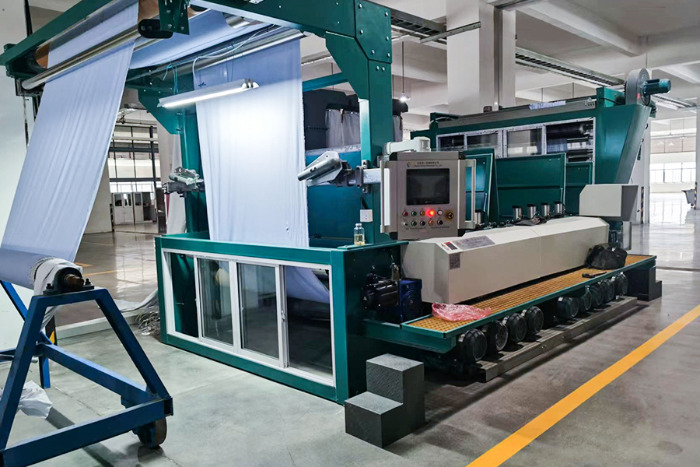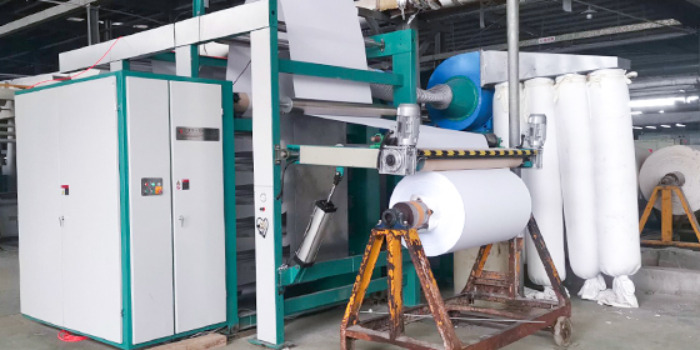In the textile finishing process, suede effect or brushed fabric is highly desirable for creating soft, luxurious textures on various materials. The combined sueding machine is used to achieve this finish, and it comes in two primary configurations: Horizontal Combined Sueding Machines and Vertical Combined Sueding Machines. These machines differ in design, operation, and the types of fabrics they can process. Understanding their unique features and applications will help you decide which machine suits your specific production needs. In this article, we’ll dive into the details of both machines, their characteristics, and compare them to highlight their advantages.
Horizontal Combined Sueding Machine: Features and Applications
The Horizontal Combined Sueding Machine is one of the most commonly used machines for creating a suede-like finish on fabrics. The fabric is fed through the machine in a horizontal orientation, passing through a series of abrasive rollers and brushes that remove the fibers from the fabric surface, creating a soft, velvety texture.
Key Features:
-
Horizontal Fabric Movement: Fabric passes through the machine horizontally, ensuring an even and consistent application of the abrasive materials, which is essential for creating a uniform finish.
-
Multiple Abrasive Rolls and Brushes: These machines use abrasive rollers, brushes, and polishing components to achieve the desired suede effect. The multiple stages of abrasives allow for flexibility in adjusting the intensity of the finish.
-
Precise Control of Abrasive Intensity: Horizontal machines allow for precise control over abrasive pressure, speed, and contact time, which enables operators to fine-tune the finish based on the fabric type and required outcome.
-
Versatility: These machines are capable of processing a wide variety of fabrics, including woven fabrics, knitted fabrics, and blended materials. This makes them ideal for use in industries that handle a broad range of textile types.
Applications:
-
Garment Manufacturing: Ideal for finishing fabrics used in casual wear, sportswear, and outerwear, where a soft, brushed texture is desired.
-
Home Textiles: Used extensively in the home textile industry, where fabrics for bedding, curtains, and upholstery are treated to create soft, luxurious finishes.
-
Automotive Upholstery: Horizontal sueding machines are also used in automotive fabric production to treat upholstery materials, giving them a premium feel and appearance.
Horizontal machines are often chosen in mass production settings where versatility and high throughput are necessary. They provide an effective way to achieve a consistent, smooth finish across a wide range of fabric types.

Vertical Combined Sueding Machine: Features and Applications
The Vertical Combined Sueding Machine works similarly to the horizontal machine, but the fabric is fed vertically through the machine. The orientation of the fabric and the way it interacts with the abrasive rollers results in different characteristics, making it ideal for certain applications.
Key Features:
-
Vertical Fabric Movement: The fabric is fed vertically, which can be beneficial for handling heavier fabrics or thicker materials that may be more difficult to process horizontally.
-
Multi-stage Abrasive Process: Just like horizontal machines, vertical sueding machines use a combination of abrasive rollers, brushes, and polishing stages to create a fine, smooth, or velvety finish on the fabric. However, the vertical movement may allow for better tension control and evenness in the finish.
-
Compact and Space-efficient: Vertical machines are typically more compact than horizontal machines, making them a good choice for facilities with limited space or for businesses looking for a more space-efficient solution.
-
High Flexibility: Despite their compact size, vertical combined sueding machines can treat a wide variety of fabrics. They are particularly effective on dense materials or heavier textiles such as denim, corduroy, and twill.
Applications:
-
Heavy Fabrics: Vertical machines are ideal for heavier fabrics like denim, corduroy, and canvas. The vertical orientation is better suited for treating these materials, providing an even and consistent suede effect without compromising the fabric's structure.
-
Technical Textiles: Vertical machines are used in industries requiring technical fabrics that need specific sueding finishes, such as protective clothing, industrial fabrics, and automotive materials.
-
Luxury Upholstery: Vertical sueding machines are popular for creating high-end finishes on upholstery materials and luxury fabrics due to their precise control over the fabric’s tension and the even application of abrasive materials.
The vertical sueding machine's ability to handle heavier materials and its space-efficient design make it ideal for businesses that specialize in specialty textiles, such as luxury upholstery, automotive fabrics, and thicker garments.

Horizontal Combined Sueding Machine vs. Vertical Combined Sueding Machine: A Comprehensive Comparison Across Multiple Dimensions
In the textile finishing industry, suede effect or brushed fabric is highly valued for its soft, velvety texture. To achieve this effect, the use of combined sueding machines is essential. These machines are available in two main configurations: Horizontal Combined Sueding Machines and Vertical Combined Sueding Machines. Both types are designed to create suede-like finishes, but they differ in various ways, including their operation, suitability for different fabrics, space requirements, ease of use, and more. In this article, we will explore the differences between these two types of machines across several key dimensions.
| Feature | Horizontal Combined Sueding Machine | Vertical Combined Sueding Machine |
| Fabric Movement | Fabric moves horizontally through the machine. | Fabric moves vertically, offering a different handling approach. |
| Suitability for Fabrics | More versatile, suitable for light to medium-weight fabrics and blended materials. | Ideal for heavier fabrics like denim, corduroy, and twill. |
| Machine Design | Larger and requires more floor space. | Compact design, great for smaller production spaces. |
| Control Over Finish | Offers precise control over abrasive intensity, pressure, and speed, ideal for uniform finishes. | Provides more consistent tension control, especially on dense fabrics. |
| Ease of Operation | Requires more manual adjustments and expertise for different fabric types. | Easier operation for heavier fabrics, especially for consistent results. |
| Applications | Best for garment manufacturing, home textiles, and sportswear. | Best suited for heavy fabrics, technical textiles, and luxury upholstery. |
Design and Fabric Handling
Horizontal Combined Sueding Machine
-
Fabric Movement: The fabric moves horizontally through the machine. This is the traditional method, where the fabric is fed across rollers and brushes in a horizontal direction, allowing for even contact with the abrasive materials.
-
Machine Size: Horizontal machines tend to be larger and require more floor space. They are typically built to accommodate large volumes of fabric, making them ideal for mass production settings.
-
Suitability: Horizontal machines are well-suited for light to medium-weight fabrics, and they can handle both woven and knitted textiles effectively. They provide consistent results across a broad range of fabric types.
Vertical Combined Sueding Machine
-
Fabric Movement: In the vertical machine, the fabric is fed vertically through the system. This orientation allows for different dynamics in how the fabric interacts with the abrasive components.
-
Machine Size: Vertical machines are generally more compact and can be used in facilities with limited space. This makes them ideal for smaller production lines or workshops where space efficiency is crucial.
-
Suitability: Vertical machines excel at handling heavier fabrics such as denim, corduroy, and twill. Their vertical design allows them to maintain better tension control over thick materials, ensuring a uniform finish.
Performance and Finish Quality
Horizontal Combined Sueding Machine
-
Control over Finish: Horizontal machines allow for fine-tuning the abrasiveness, speed, and pressure at which the fabric passes through the abrasive rollers. This level of precision makes them ideal for achieving a consistent, uniform finish across various fabric types.
-
Finish Quality: Horizontal machines are excellent for producing a soft, velvety texture with an even finish on light to medium fabrics. The ability to control pressure and speed ensures minimal damage to the fabric while achieving a high-quality suede effect.
Vertical Combined Sueding Machine
-
Control over Finish: Vertical machines generally offer consistent tension control, which is crucial when working with heavier fabrics. The vertical orientation helps ensure an even application of abrasives, especially on dense textiles.
-
Finish Quality: Vertical machines are typically used for fabrics that require a more durable, high-quality finish, such as luxury upholstery and automotive textiles. The precise tension control provided by vertical orientation ensures that thicker fabrics achieve a smooth and even sueding effect.
Fabric Types and Applications
Horizontal Combined Sueding Machine
-
Versatility: Horizontal machines are highly versatile and can handle a wide range of fabric types. They are particularly suited for lighter fabrics, blended textiles, and garments. Their versatility makes them ideal for large-scale production of casual wear, sportswear, bed linens, curtains, and other textile products.
-
Ideal for:
-
Garment Manufacturing: Creating soft finishes on fabrics used for outerwear, sportswear, and casual clothing.
-
Home Textiles: Finishing fabrics for bedding, upholstery, and curtains.
-
Automotive Textiles: Suede finishes for car upholstery and interior materials.
-
Vertical Combined Sueding Machine
-
Fabric Type Specialization: Vertical machines are best for heavier fabrics, such as denim, corduroy, and canvas. They are designed to handle thicker materials that require more precise control over fabric tension.
-
Ideal for:
-
Heavy-Duty Fabrics: Sueding finishes for denim and corduroy used in jeans, jackets, and outerwear.
-
Luxury Upholstery: Treating luxury fabrics used in furniture upholstery or automotive interiors.
-
Technical Textiles: Specialized fabrics requiring a precise, consistent sueding effect, such as protective clothing or industrial textiles.
-
Cost and Space Efficiency
Horizontal Combined Sueding Machine
-
Cost: Horizontal machines are generally more expensive than vertical machines due to their larger size, higher capacity, and increased versatility. The cost is often justified by the higher production volume and diverse fabric types they can handle.
-
Space Efficiency: Due to their large size, horizontal sueding machines require a significant amount of floor space. This could be a limiting factor for small businesses or facilities with limited floor area.
Vertical Combined Sueding Machine
-
Cost: Vertical machines tend to be more cost-effective for smaller businesses due to their more compact design and lower initial investment. They also offer excellent value when the primary focus is on heavy fabrics or specialty applications.
-
Space Efficiency: Vertical machines are space-saving, making them ideal for businesses with limited space or those seeking smaller-scale operations. Their compact nature also makes them easier to integrate into existing production lines.
Ease of Operation and Maintenance
Horizontal Combined Sueding Machine
-
Ease of Operation: Horizontal machines often require more manual adjustments and expertise from operators, especially when switching between different fabric types or adjusting for desired finishes. The larger machine size may also lead to more complex operations.
-
Maintenance: Horizontal machines may require more maintenance due to the larger number of moving parts and abrasive rollers. Regular cleaning and upkeep are essential to maintain performance and fabric quality.
Vertical Combined Sueding Machine
-
Ease of Operation: Vertical machines are generally easier to operate than horizontal machines. The fabric's vertical orientation allows for smoother fabric handling, and the machine typically requires less intervention during operation, especially for heavier fabrics.
-
Maintenance: Vertical machines have fewer components and a simpler design, making them easier to maintain. With fewer moving parts, these machines often require less frequent servicing and maintenance compared to horizontal models.
Energy Efficiency
Horizontal Combined Sueding Machine
-
Energy Consumption: Horizontal machines typically consume more energy due to their larger size and higher throughput. However, this can be offset by their ability to handle large volumes of fabric efficiently.
-
Power Requirement: Horizontal machines generally require more power to operate, making them less energy-efficient compared to vertical machines. However, for businesses with high production needs, the energy cost may be justified by the higher output.
Vertical Combined Sueding Machine
-
Energy Consumption: Vertical machines tend to be more energy-efficient due to their compact design and smaller operational size. They use less power to operate, making them more suitable for smaller-scale operations.
-
Power Requirement: Vertical machines have lower power requirements, reducing overall energy costs for businesses that prioritize energy efficiency.
Understanding the Strengths of Both Machines
Both Horizontal Combined Sueding Machines and Vertical Combined Sueding Machines have their own distinct advantages, making them suitable for different types of fabrics and production environments.
-
Horizontal Combined Sueding Machines excel in versatility and are ideal for large-scale production of a variety of light to medium-weight fabrics. They are better suited for industries that require high-volume production and consistent finishes across multiple fabric types.
-
Vertical Combined Sueding Machines, on the other hand, are perfect for handling heavier fabrics and are ideal for applications requiring precise fabric tension control and consistent results. Their compact design and cost-efficiency make them a great choice for businesses with limited space or those working with specialty fabrics.
Both machines are valuable in different contexts, and understanding their unique strengths will help you choose the right option based on your production scale, fabric types, space constraints, and budget.
Key Differences and Why Each Is Valuable
Both the Horizontal Combined Sueding Machine and the Vertical Combined Sueding Machine have specific advantages depending on the type of fabrics being processed and the production requirements.
-
Horizontal Combined Sueding Machines are more versatile, capable of handling a broader range of fabric types, including knitted, woven, and blended fabrics. This flexibility makes them suitable for industries such as garment manufacturing and home textiles, where high-volume production and uniform finishing are required. Additionally, horizontal machines offer greater adjustability, making them ideal for lighter fabrics and multifunctional use.
-
Vertical Combined Sueding Machines, on the other hand, excel in processing heavier fabrics and provide better control over fabric tension. This is particularly beneficial for industries that specialize in denim, corduroy, or luxury fabrics, where the consistency of the sueding effect is paramount. Their compact design also makes them ideal for space-conscious facilities.

 简体中文
简体中文 English
English عربى
عربى





